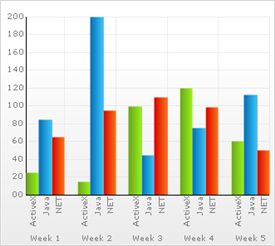UltraChart.Axis.Y.Labels.ItemFormatString = "<DATA_VALUE:##.##>"This topic discusses useful information that will help you to ensure that your data is rendered properly in the 2D column chart.
While the Chart control allows you to easily point the chart to your own custom data, it is important that you are supplying the appropriate amount and type of data that the chart requires. If the data does not meet the minimum requirements based on the type of chart that you are using, an error will be generated.
The following is a list of data requirements for 2D column charts:
The data set contains one or more numeric columns.
If you are binding the 2D column chart to a series object, see Requirements for Series Binding for information on the series binding requirements.
If you are using the 2D column chart in a composite chart, see Axis Requirements for Composite Charts for information on the axis requirements for the chart.
The chart data is rendered using the following rules:
Each row is drawn separately as a group of vertical columns. These groups of columns are called a "series".
Each series displays series labels below the x-axis. Data values are represented by the height of the column along the y-axis. Series can be separated by an interval of SeriesSpacing column widths.
Every numeric column is displayed in the chart. A numeric column is any DataColumn that contains only values that can be interpreted as numbers.
The first string column encountered in the data will be used for row labels.
You can select an alternate column to be used for row labels, and toggle between the primary and secondary labels.
You can include or exclude any column from the chart using the UltraChart.Data. IncludeColumn method.
The x-axis (or horizontal axis) is a SetLabelAxis object, with the points evenly spaced apart by series (group) and item (column). The y-axis (or vertical axis) is the numeric axis. Labels on the y-axis can be formatted using the FormatString property and a “numeric format”:
UltraChart.Axis.Y.Labels.ItemFormatString = "<DATA_VALUE:##.##>"See below for an example data set, along with the rendered 2D column chart.
